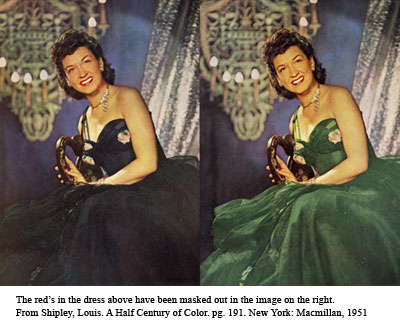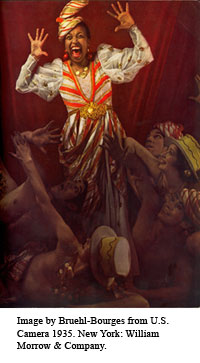Here is a little background information on Julia Peterkin and Doris Ulmann. The two woman seem to have come to the collaboration that resulted in Roll, Jordan, Roll with different goals.
Doris Ulmann
Doris Ullmann was a well-off woman of Jewish descent and humanist upbringing who lived in New York. (Jacobs, 3). She studied under Clarence White, and her work was associated with Pictorialists such as Stieglitz and Steichen. (Jacobs, 88). She got her start photographing intellectuals in New York, but it was as a photographer of the rural poor that she became famous, and found her passion. (Jacobs, 74)
I thought that the poverty and manual pursuits of the subjects in Roll, Jordan, Roll were an indication of racism in Ulmann. After all, southern black farmers were beginning to head up north to find better work, but these migrants do not appear in Roll, Jordan Roll. (Newhall, 26). However, race had little to do with the choice of sitters. Ulmann had been trying to find a particular sort of American rural “type” since 1925, and this type had little to do with race. She photographed Shakers, Dunkards, Mennonites, and the craftsmen of Appalachia, but also Native Americans and, obviously, Southern blacks (Jacobs, 55). Perhaps she was responding to the ideas instilled in her during her elementary and college education under Felix Adler at the Ethical Culture School in Manhattan. (Newhall, 28). Adler taught that “there is such a thing as national character, national genius, or national individuality.” (Adler, 98). Perhaps Ulmann sought to capture what was best in America. She may have also been responding to a perception in the 1930’s that rural communities were being squeezed out by increasing mechanization (Collins, 55). There may have been a certain paternalistic and nostalgic slant to Ulmann’s choice of sitters, but it was to her credit, I think, that she did not define her ideas of rural Americans using color lines.

In the images from Handicrafts of the Southern Highlands, white Appalachian basket weavers, potters and musicians are also shown engaged in tasks which do not require literacy, and wearing rather picturesque work clothes. Her choice to concentrate on some of the more marginal members of Gullah society can be explained by Ulmann’s need for interesting faces, rather than a wish to portray the Gullah as a subject people. She wrote: “a face that has the marks of having lived intensely, that expresses some phase of life, some dominant quality or intellectual power, constitutes for me an interesting face. (Jacobs, 86)
The individualism Ulmann shows in the portraits for Roll, Jordan, Roll was also a motif to be found in all of her work, and not a response to the race of her photographic subject. She wrote: “Whenever I am working on a portrait, I try to know the individuality or real character of my sitter and, by understanding him, succeed in making him think of the things that are of vital interest to him. (Jacobs, 85). Though she said that working with the African-Americans in South Carolina was “difficult”, because they were so “strange” and “self-conscious”(Jacobs, 64), she told stories to elicit responses from her black sitters as she said was her usual way of working. One of her black sitters, a man named Dale Warren, said Ulmann would tell “a funny story to make you laugh and another not so funny to see if you are easily reduced to tears”(Newhall, 28). 
Julia Mood Peterkin
Julia Mood Peterkin was a rich woman from South Carolina. Her mother died when she was very young, and she was raised by a Gullah nursemaid. In 1903, she married the plantation owner William Peterkin and moved to his 15 hundred acre cotton plantation called Lang Syne (Jacobs, 62). In the early years of her marriage, her Gullah servants were some of her closest friends (Williams, 17). She used real events in the lives of the workers on Lang Syne as the seeds for growing her stories (Williams, 19). She felt stifled playing the role of the good southern woman, and she referred to the day that she was discovered as a writer as her true birthday (Williams, 30).
She published four novels and numerous shorter works about southern black culture before she began work on Roll, Jordan, Roll. One of the four novels, Scarlet Sister Mary, received a Pulitzer Prize in 1932 (Durbam, 34). The characters in the novels are passionate individuals and representatives of a fierce fight for survival (Kriedel, 470). She told stories of abortions and cruelty when no one else would. Though a few of her short works included harsh criticism of the double standard applied to blacks and whites (Williams, 51), the novels are told through Gullah characters, and include little mention of whites at all (Newhall, 26). Peterkin stated that she meant “to present these people in a patient struggle with fate, and not in any race conflict at all” (Kreidler, 468).
Roll, Jordan, Roll was a departure from this established formula of how to craft a book. As I mentioned in my earlier post, Roll, Jordan, Roll is a mix of third and first person narrative with anecdotes and superstitions thrown in, a mix Peterkin was not comfortable with. In a letter to a friend she wrote: “my chief worry is [the book’s] lack of form with sketches mixed together in dangerous confusion” (Jacobs, 126). She was right to worry. The most egregiously paternalistic passages of Roll, Jordan, Roll are those in which she describes the plantation and its history. By keeping herself and all whites out of her novels, Peterkin avoided her own compromised position as a plantation mistress. In the initial chapter of Roll, Jordan, Roll she has to speak with her own voice about her home of thirty years, Lang Syne. The result seems nostalgic and deluded.
In 1925 Peterkin wrote a novel from the view point of a white plantation mistress (Williams, 89). The result was the confusing and contradictory work called On the Plantation. When Peterkin asked H. L. Mencken how to fix the work, he advised her to “take out the white woman” (Williams, 95). On the Plantation sans white woman became the powerful novel Black April. Apparently, Peterkin’s position as white plantation mistress was too contradictory for her to address it with lucidity or strength.
The more I read about the making of Roll, Jordan, Roll, the more interesting the viewpoints of its two authors became. Both woman had contradictory opinions about their subjects, hardly surprising from artist approaching issues of race. Perhaps the primary difference between the tone of the images in Roll, Jordan Roll, and the tone of the text, is that Ulmann could keep herself behind the camera while Peterkin revealed to much.
- Adler, Felix. “The Moral Instruction of Children.” New York: D. Appleton & Co., Publishers, 1892. Project Gutenberg. Web. 7 Mar. 2012. URL: http://www.gutenberg.org/catalog/world/readfile?fk_files=2363349
- Collins, Lisa Gail. “Visualizing Culture: Art and the Sea Islands.” International Review of African American Art. 19.1 (2003): 54-59.
- Durbam, Frank. “The Reputed Demises of Uncle Tom; Or, the Treatment of the Negro in Fiction by White Southern Authors in the 1920’s.” The Southern Literary Journal. 2.2 (Spring, 1970): 26-50. JStor. Web. 16 Mar. 2012. URL: http://www.jstor.org/stable/20077383
- Eaton, Allen H. “Handicrafts of the Southern Highlands.” New York: Russell Sage foundation, 1937.
- Jacobs, Philip Walker. The Life and Photography of Doris Ulmann. Lexington, Kentucky: University Press of Kentucky, 2001.
- Kreidler, Jan. “Reviving Julia Peterkin as a Trickster Writer”. Journal of American Culture. 29.4 (Dec. 2006): 468-474. Ebscohost Omnifile. Web. 7 Mar. 2012.
- Lamuniere, Michelle C., “Roll, Jordan, Roll and the Gullah Photographs of Doris Ulmann.” History of Photography. 21.4. (Wint. 1997): 294-302.
- Newhall, Beaumont. “Photographing America’s South: Roll, Jordon roll.” Artonview. No.58 (Wint. 2009). Web. Ebscohost Omnifile. 7 Mar. 2012.
- Williams, Susan Millar. “A Devil and a Good Woman Too: The lives of Julia Peterkin.” Athens, Georgia: University of Georgia Press, 1997.
 It is in this task, finding books for customers, that Bank Street is essentially different from Cooper Library. At Cooper, the librarians and staff are instructed to show patrons how to find a book and then back off and let the patron find it for themselves. Bank Street Bookstore is all about personally selling the book to the patrons. It is often not even possible for a patron to find a book without aid.
It is in this task, finding books for customers, that Bank Street is essentially different from Cooper Library. At Cooper, the librarians and staff are instructed to show patrons how to find a book and then back off and let the patron find it for themselves. Bank Street Bookstore is all about personally selling the book to the patrons. It is often not even possible for a patron to find a book without aid. Access to the catalog would not help bookstore patrons much anyway because the catalog does not have the robust search capabilities library workers expect. Searchers can not use more than three keywords, and there is no way to use multiple fields in the same search. Because the system has to use the college’s overworked servers, 20-60 second lags are common. The system does not need to be simple, fast, or self-explanatory because only highly trained staff will ever use it.
Access to the catalog would not help bookstore patrons much anyway because the catalog does not have the robust search capabilities library workers expect. Searchers can not use more than three keywords, and there is no way to use multiple fields in the same search. Because the system has to use the college’s overworked servers, 20-60 second lags are common. The system does not need to be simple, fast, or self-explanatory because only highly trained staff will ever use it.






















